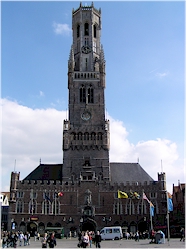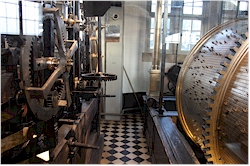|
Picture: view on the belfry tower from the Wollestraat |
|
» Eating » Sleeping facilities » Going out in Bruges » Fixed events » Beguinage » Belfry and halls » Chapel of the Holy Blood » Court of the Princes » Dunes abbey » Guild houses of Bruges » Hospices of Bruges » Jerusalem church » Nation houses » Our Ladies church » Poortersloge » St-Anna's church » St-Donatian's cathedral » St-John's hospital » St-Saviour's cathedral » Town gates » Town hall » Windmills of Bruges » Complete overview... » Archeology museum » Brangwyn museum » Brewery museum » Chocolate museum » Diamant museum » Folklore museum » Frites museum » Groeninghe museum » Guido Gezelle museum » Halve Maan » Lace museum » Lamps museum » Memling museum » Museum of Fine Arts » Salvador Dali museum » St-Janshuismill » St-John's hospital » Complete overview... » Boterhuis » Boudewijn Seapark » Burg » Canals (Reien) » Coupure » De Garre » Grote Markt » Historium » Huidevettersplein » Jan Van Eyckplein » Lake of Love (Minnewater) » Rozenhoedkaai » Simon Stevinplein » 't Zand » Complete overview...
|
The belfry and halls of Bruges
The tower houses a carillon and a giant clock. From the top you have a great view on the historic center of Bruges and the surrounding area.
The halls were built for commercial purposes. They served as a covered market and as a storage for stocking goods. You will still find a few shops in the halls but they are now mainly used for exhibitions. Short history. In its base, the complex dates back to the 13th century, the upper part of the tower however was only built at the end of the 15th century and used to have a peak until 1741 when a fire destroyed it. The halls and the tower were restored after each incident (E.g. a big fire in 1280) and adapted to the changing needs. You can notice several elements from different architectural styles. Location: Markt 7
Picture 1: the belfry and eht halls seen from the Markt |
» getting to Bruges » transport, tours, links,...
|
|
© xplorengo.com. Information is provided from the location and various sources, we do not hold any responsibility with regard to information provided by others. xplorengo is not a travel agency and does not promote or organize trips we therefore hold no responsibility with regard to third parties that promote their services via us. No information or pictures can be copied or distributed in any way without written permission of xplorengo.com. All pictures are made and copyrighted by Hendrik De Leyn unless mentioned otherwise [Contact information]. |

